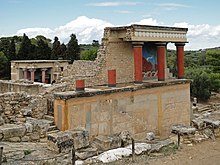Knossos
Κνωσός | |
 Restored North Entrance with charging bull fresco | |
 Crete, showing Heraklion, location of ancient Knōsos | |
| Alternative name | Cnossus |
|---|---|
| Location | Heraklion, Crete, Greece |
| Region | North central coast, 5 km (3.1 mi) southeast of Heraklion |
| Coordinates | 35°17′53″N 25°9′47″E / 35.29806°N 25.16306°ECoordinates: 35°17′53″N 25°9′47″E / 35.29806°N 25.16306°E |
| Type | Palace complex, administrative centre, capital of Crete and regions within its jurisdiction |
| Length | North-south length of inhabited area is 5 km (3.1 mi)[1] |
| Width | East-west width of inhabited area is 3 km (1.9 mi) max. |
| Area | Total inhabited area: 10 km2 (3.9 sq mi). Palace: 14,000 m2 (150,000 sq ft)[2] |
| Height | Unknown |
| History | |
| Builder | Unknown; Daedalus according to Greek mythology |
| Founded | First settlement about 7000 BC. First palace dates to 1900 BC. |
| Abandoned | Some time in Late Minoan IIIC, 1380–1100 BC |
| Periods | Neolithic to Late Bronze Age. First palace built in the Middle Minoan IA period. |
| Cultures | Minoan, Mycenaean |
| Associated with | Middle Minoan: people of unknown ethnicity termed Minoans Late Minoan: Mycenaean Greeks |
| Site notes | |
| Excavation dates | 1900–1931 1957–1960 1969–1970 |
| Archaeologists | Initial discoverers of the palace: Arthur Evans; David George Hogarth, Director of the British School of Archaeology at Athens; Duncan Mackenzie, superintendent of excavation; Theodore Fyfe, Architect; Christian Doll, Architect For the additional work on the Neolithic starting in 1957: John Davies Evans |
| Condition | Restored and maintained for visitation. |
| Management | 23rd Ephorate of Prehistoric and Classical Antiquities |
| Public access | Yes |
| Website | "Knossos". British School at Athens. "Knossos". Odysseus. Hellenic Ministry of Culture and Tourism. 2007. Archived from the original on 2007-06-17. |
Knossos (also Cnossos, both pronounced /(kə)ˈnɒsɒs, -səs/; Ancient Greek: Κνωσός, romanized: Knōsós, pronounced [knɔː.sós]; Linear B:
